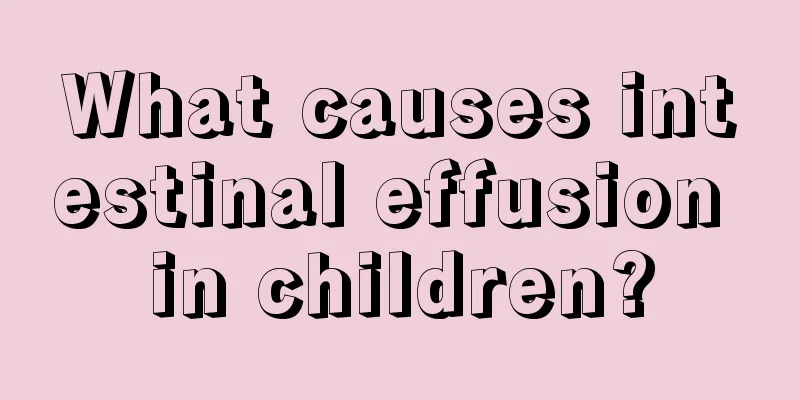What causes intestinal effusion in children?

|
Most of the time, intestinal effusion in babies is caused by intestinal obstruction. Generally, intestinal obstruction occurs after bowel movements stop, and the body will experience abdominal pain, bloating and other symptoms. If the baby does not have this symptom, it is best to take the baby to the hospital for a detailed examination in time. After finding out the cause, then treat it symptomatically. Children's intestinal effusion must be treated as early as possible. The earlier the treatment, the more conducive it is to control the disease in time. 1. What is the cause of peritoneal effusion in children? Increased portal vein pressure: Under normal circumstances, the hepatic sinusoidal pressure is very low (0-2 mmHg). When portal hypertension occurs, the hepatic sinusoidal hydrostatic pressure increases (portal vein pressure is 1 mmHg, which is the basic condition for the formation of ascites). A large amount of fluid flows into the Disse space, causing excessive production of hepatic lymph fluid. The volume of lymph in patients with cirrhosis is often 20 times that of normal people. When the thoracic duct cannot drain the excessive lymph fluid, it leaks directly from the liver capsule into the abdominal cavity to form ascites. Increased sinusoidal pressure can also cause activation of intrahepatic pressure receptors, which, through the hepatorenal reflex, reduces renal sodium excretion and aggravates water and sodium retention. What is the cause of peritoneal effusion in children? Visceral artery dilation: In the early stages of cirrhosis, visceral blood vessels dilate, maintaining effective blood volume within a normal range by increasing cardiac output and heart rate. In the advanced stage of cirrhosis, visceral artery dilation becomes more obvious, resulting in a significant decrease in effective arterial circulating blood volume and a drop in arterial pressure, which in turn activates the sympathetic nervous system, the renin-angiotensin-aldosterone system, and increases the release of antidiuretic hormone (ADH) to maintain arterial pressure, causing renal vasoconstriction and sodium and water retention. Portal hypertension interacts with visceral vasodilation to change intestinal capillary pressure and permeability, facilitating fluid accumulation in the peritoneal cavity. 2. Clinical manifestations of peritoneal effusion In addition to peritoneal effusion, there are often symptoms and signs of the primary disease. Physical examination of ascites caused by heart disease may reveal signs such as cyanosis, peripheral edema, distended neck veins, enlarged heart, precordial tremor, hepatosplenomegaly, arrhythmia, and heart valve murmur. Liver disease often presents with dull or sallow complexion, yellow skin and sclera, spider nevi on the face, neck or chest, or palms of the liver, varicose veins of the abdominal wall, hepatosplenomegaly and other signs. Ascites caused by kidney disease may cause signs such as pale complexion and peripheral edema. Flushed face, fever, abdominal tenderness, and a feeling of flexibility of the abdominal wall may indicate tuberculous peritonitis. Patients with weight loss, cachexia, swollen lymph nodes or abdominal masses are mostly suffering from malignant tumors. It is often accompanied by fever, nausea, vomiting, abdominal distension and severe abdominal pain. Bloody ascites generally presents as symptoms of acute blood loss, with the patient appearing pale, with cold and clammy skin, rapid breathing, irritability, a weak pulse, low blood pressure, and even going into shock. 3. How to check peritoneal effusion Laboratory tests Impaired liver function and hypoproteinemia may indicate cirrhosis, while large amounts of proteinuria, elevated blood urea nitrogen and creatinine indicate impaired renal function. Immunological examinations are also important for the diagnosis of liver and kidney diseases. Examination of peritoneal puncture fluid can determine the nature of ascites and identify the cause of ascites. What is the cause of peritoneal effusion in children? Physical examination In addition to shifting dullness, there are often signs of the underlying disease. |
<<: When do children lose their teeth?
>>: What are the causes and treatments of hair loss in children?
Recommend
Your child doesn’t like to eat fruit? 5 tips to make your kids fall in love with fruit!
Your child doesn’t like to eat fruit? 5 tips to m...
One of the child's testicles is larger than the other
Many parents find that one of their children'...
What is the correction method for overbite of deciduous teeth?
As the old saying goes, don't show your teeth...
What are the developmental indicators of a five and a half month old baby?
After the baby is born, the development standards...
How to treat rectal polyp surgery in children?
If a child suffers from rectal polyps, the main s...
Can children eat ginseng?
Ginseng is a relatively precious Chinese medicina...
The child suddenly convulsed and foamed at the mouth
1. Age factor: The causes of epilepsy are differe...
How old can babies take calcium supplements?
Calcium can promote bone growth and plays a vital...
What causes green stool in children?
Stool can also show whether people are suffering ...
Yellow thorn on baby's scalp
Nowadays, many babies will have a layer of yellow...
How many days does it take for chickenpox to completely break out?
Compared to children, adults can also suffer from...
What are the methods of making baby steamed buns?
Many mothers like to make some delicious food for...
What should I do if my baby has eye mucus after waking up?
For newborn babies, since their resistance is rel...
What is precocious puberty
In recent years, the term "precocious pubert...
Why does my seven-month-old baby always scratch his ears?
Many parents find that their babies have develope...









